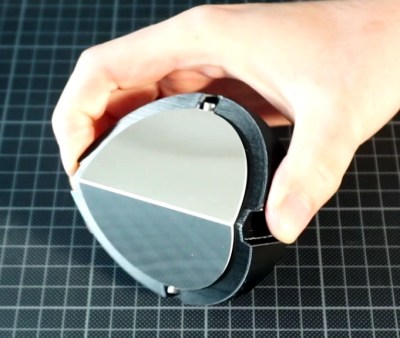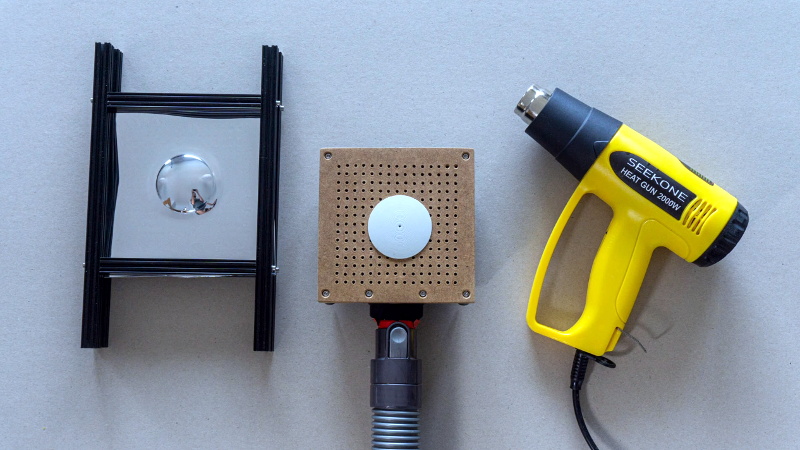Generally speaking, creating custom mirrors is a complex task that involves a lot of careful grinding, and isn’t something to be taken lightly if you need precision results. Just ask the folks who provided NASA with a wonky mirror for the Hubble. But assuming you’re not working on an orbital space telescope (or even a ground based one, for that matter), [volzo] has recently documented some techniques for producing single and double curved mirrors of reasonable quality using common workshop tools.
 The first step is finding something that’s a bit easier to work with than glass. After testing various reflective materials such as PVC foil and painted PETG sheets by comparing the reflections of projected test patterns, [volzo] found that laminated polystyrene gave the most accurate results. If you just want to make a simple bent mirror, he shows how you can pop one of these sheets on a CNC router, make the appropriate cuts, and fold them into shape.
The first step is finding something that’s a bit easier to work with than glass. After testing various reflective materials such as PVC foil and painted PETG sheets by comparing the reflections of projected test patterns, [volzo] found that laminated polystyrene gave the most accurate results. If you just want to make a simple bent mirror, he shows how you can pop one of these sheets on a CNC router, make the appropriate cuts, and fold them into shape.
That part might seem a bit obvious, but what about a more complex shape? Here, [volzo] points to how the thin sheets of polystyrene also lend themselves to vacuum forming. As demonstrated in the video below, all it takes is a 3D printed plug and some basic equipment to rapidly produce mirrors in arbitrary shapes.
Now obviously the optical properties of such mirrors will leave something to be desired, but depending on your application, that might not be such a big deal. As examples [volzo] shows off a few projects using these custom mirrors, such as a tabletop camera that captures both sides of the table simultaneously and a circular projector. Laminated polystyrene could potentially even be used to create low-cost variable mirrors.
















This guy has a great blog, very cool projects!
Well done video. All meat, no chat. He does kind of hurry over the mold blank prep though. I’ve done thermo vacuforming and getting the mold perfect is a big part of the process. Must be super smooth – even 50 micron flaws will show up.
As long as we’re talking thermoforming, that polystyrene cools really fast so have a very strong vacuum available and don’t waste any time between heat and vacuum. I use a secondary vacuum chamber (30 Liter tank) for my bigger vacuforming setups.
This looks really interesting, but I haven’t seen any mirror polystyrene for sale in Michigan, USA. Is mirror polystyrene only available in the EU?
I have seen a lot of acrylic mirrors listed in the USA, but none from polystyrene.
You may find metallized vinyl (PVC) easier to get in the USA. Just make sure that that it’s not too thin (0.5mm is minimum, 1mm works better). Acrylic (PMMA) is a bit harder when it comes to thermoforming.
Thanks for the follow-up!
Yes, it looks like mirror PVC is readily available here, though it is much thicker (1/8″; 3.175mm). I’ll keep looking for a better material thickness, but I might also try the 3 mm sheeting. On the plus side, it might better mask the imperfections in the 3d printed object to be duplicated.
How did you cut the pre-formed mirror from the sheet? Or did you adapt the vacuum forming frame to match the pre-cut blank? I guess that a simple hand saw should work, but I won’t be able to make very nice edges.
I appreciate how well your blog on the subject is both thought through, and written up!
I did use a hobby knife to cut the part from the sheet after forming. The edges won’t be perfect, but depending on your design they are not visible to the camera or projector anyway.
OR, you could take acryllic, bend it into shape and use simple mirror spray on the back, and the front becomes reflective.
Tried that. Rust-Oleum is what is generally referred to as having the best reflective properties when it comes to mirror spray and it’s looking pretty horrible. You’ll find a comparison in the video/blog post.